FINE ARTS,
THE SCULPTURE OF GAETANO AND RAFFAELE MONTI.
In a amall room at the house of Messrs. Colnaghi, in Pall Mall East, are some of the most beautiful works of sculpture from living hands which it has been our fortune to see.
The figure which occupies the principal place is a monumental effigy; it represents the deceased Lady de Manley reclining on the bed of death. It is not strictly a portrait; for the sculptor never saw Lady de Manley; and the figure is that of a lady in the prime of life, not advanced in ) ears; but some resemblance has been caught from a picture painted in her yea& The object was to represent rather the idea of the lady, and very sweetly is that done. The figure lies supine; the attitude is one of simple repose;
the figure is womanly, but is modestly and appropriately indicated as it lies half sunk in the bed, rather than rudely chiselled out; the aspect is that of a gentle and unaffected lady. The artist, we think, has been particu- larly happy, not less in the degree of reserve which be has imposed upon hitrtself, than in the felicity with which he has suggested just the idea that must have been desired to grace the monument. This figure is by Signor Gaetano Monti, brother of the eminent Italian poet.
The rest of the works in the room are by the venerable sculptor's son, Raffaele; who has brought the whole set over to England. He has con- tributed two very graceful kneeling figures, Prayer and Resignation, which form part of the monumental group; and also several others which we must notice individually.
" Innocence " is represented by a couple of children, a boy and girl, about the size of life. The boy, kneeling, points with a face of smiling amusement to a poisonous snake, that rears its head close to the little finger: the child knows neither fear, nor danger, nor suspicion. The girl stands by his side; her sole garment is gathered up to hold a few flowers, of the not losing which she is more careful than of deranging her dress; the boy's arm is round her waist: she too is unconscious of danger or shame The pretty infantine action, something between alertness and helplessness, is well conceived. The girl's head and throat perhaps are too womanly; but the defect is slight, and does not materially mar the general effect or expression.
The effigy of a veiled Vestal tending the everlasting flame, is a curiosity in sculpture-a feat of art. The figure is the size of life; it is clothed in a robe, and a veil thrown over the head envelops the face, shoulders, and part of the arms: this veil is transparent! Not merely do you discern the covered forms, where they actually swell out and touch the veil, but you. think you can see, through the veil, underneath, the fully and delicately finished features of a most beautiful face: you can detect the retreating curves of the profile, and the swelling forms of the lips, with a space between that softly but crisply rounded flesh and the covering gauze. You are deceived. Working in the transparency of the marble, with cunning skill the sculptor has so arranged the thinness and thickness of his ma- terial, that the refracted light suggests the forms beneath, which are not carved. The artist has chiselled the outward form of the veil, and in doing so has painted the veiled face in the light and shade glancing through the marble. He calls it " uno scherzo ": and it is so; but it is much more- it is a very beautiful figure.
The conceit took so well with amateurs, that Signor Raffaelle was urged to produce many versions of it; and one is a small figure of Christianity after the Roman Catholic idea-kneeling, clinging to the cross, and veiled from the too searching scrutiny of the profane. This idea is charmingly conveyed: the clinging trust conjoins the active piety with the submissive resignation which animate the representative of Christianity.
In the figure of Margaret examining the jewels left in her chamber by Faust, we are again upon the plain ground of unveiled sculpture. The form and expression of the face are based upon a German type of counte- nance. Margaret is seated on a chair, in an easy and simple posture; a string of jewels lies partly in her lap, partly in her slightly raised hands; a look of pleasure, of soft yielding, and vague abstraction, has stolen over her countenance. Her face and form exquisitely unite virgin purity and voluptuous roundness of form; the marble assumes the softness of flesh, and yet retains.the crispness of youth-the "Serso avorio" of the poet; the unfastenea garment, which Margaret, in the forgetfulness of temptation, suffers to fall about her lovely arms, droops and folds upon itself with the softness of woven stuff. The sculptor has expressed his meaning with all the force and all the exquisite delicacy of a true poet.
A nymph about to bathe is not less beautiful; it also is a poem in marble. This is executed upon an Italian type, in a middle size. A naked nymph, clinging with both hands to a slender tree-trunk, creeps sidling down a bank, and with a smile of pleasure just touches the surface of the water with her pointed toe. Voluptuous roundness and feminine agility characterize the goddess of the woody stream; grace is in every line; life animates every limb, plays upon swelling and retracting forms, and triumphs in the face; which looks down upon the water, joyously intent, with a dash of sweet audacity.

























 Previous page
Previous page